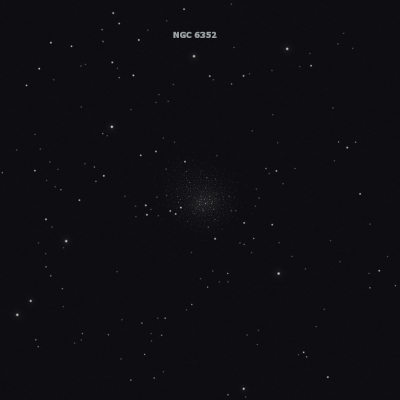
James Dunlop discovered NGC 6352 = D 411 on 14 May 1826 and recorded "A rather faint nebula, of an irregular round figure, 4' diameter, slightly branched; easily resolvable into stars, with slight compression of the stars to the centre." His position is ~15' too far east (typical error). John Herschel didn't observe this globular from the Cape, so it doesn't have a General Catalog designation.
E.E. Barnard independently found it on 7 Jul 1885 (Sidereal Messenger 4, page 223) and assumed it was new since it was missing from the General Catalog, but Lewis Swift informed him of Dunlop's prior discovery.
200/250mm - 8" (7/13/91 - Southern Baja): moderately bright, fairly large, 5' diameter, fairly low surface brightness, not condensed, brighter core but no sharp nucleus. Partially resolved into 5-10 faint stars mostly on the SW side.
300/350mm - 13.1" (7/12/86): faint, small, diffuse, low surface brightness spot. A few faint stars are off the SW edge but there is no resolution. This is the farthest southern globular I've observed from Northern California (Digger Pines) with an elevation of only a couple of degrees.
400/500mm - 18" (7/10/02 - Magellan Observatory, Australia): fairly bright, fairly large. Even at 128x, the cluster was fairly well-resolved into roughly 75 stars. It displayed a rather loose concentration class with a broad central concentration to a moderately bright 3' core. The irregular halo extended to nearly 8' diameter. Set in a rich Milky Way field.
Notes by Steve Gottlieb